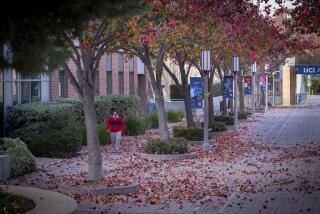UC charges higher fees to broader range of graduate students
Future social workers, architects and urban planners studying at the University of California are about to get a change in status they might not want.
Starting next year, these UC students will be considered “professional” degree candidates and will be required to pay as much as $8,000 more a year in student fees than they do now. They will join law, business and medical students, among others, who have paid big surcharges for years. And some people say that isn’t fair.
As the UC system grapples with state funding cuts, its leaders recently approved steep increases in the charges that students in professional graduate schools must shell out on top of regular student fees. The regents also added seven programs to those required to pay the surcharges, with landscape design, social work and physical therapy majors now among students who will face them.
Some critics say the university’s actions are based on the erroneous idea that all professional school graduates land well-paying jobs and can easily repay their loans. And they say the university is losing the soul of a low-cost public institution.
“The state and the regents are putting the burden of the state budget gap on the students and the real concern is about the privatization of the university,” said Jessica Luk, a UC Berkeley graduate student in city and regional planning.
The surcharges will affect about 12,000 professional school students, pushing their total UC fees 46% to 230% higher than those of graduate students in such programs as English or chemistry.
Administrators say the professional programs, with personal mentoring and often higher faculty salaries, are more costly to run than other graduate programs. The new fees are intended to prevent further cuts to teaching staff and other services, UC officials say.
“Nobody is happy, nobody wants to raise fees. At the same time, we have an obligation to put on the highest quality educational program we can,” said Franklin D. Gilliam Jr., dean of UCLA’s School of Public Affairs. The school is planning to charge $5,200 more next year for its master’s in social welfare and urban planning, matching a previously established fee for the master’s in public policy, and bringing a California student’s total annual costs to about $19,000, not including room and board.
Without the extra revenue, Gilliam said, the school would have to lay off nontenured teachers who lead field work courses that are important to academic accrediting agencies.
UC pledges that at least a third of the new revenue will be used to bolster financial aid, especially for students already enrolled. But critics contend that some low- and middle-income applicants might still be scared away.
Under the new fee schedule, UC Berkeley’s Boalt Hall law school will have the highest professional fee, a $31,355 surcharge that will bring total annual costs for California residents, not including room, board and books, to $44,200, up 21% from this year. Among professional degrees with the lowest fee will be the social welfare program at the same campus, where a new $4,000 charge will bring the total to $18,163.
Also at UC Berkeley, Luk’s regional planning program and others in the College of Environmental Design will face a new $6,000 professional degree fee, in addition to about $14,000 in other UC charges.
In a pledge not shared by all UC programs, the college’s dean, Jennifer Wolch, said all 140 or so current students continuing next year will be shielded from the new fee. “We felt it would be unfair in mid-course to change the rules of the game,” Wolch said.
But although they’re happy for the help in the short term, Luk and others said that UC’s future and that of its graduates remain at stake. More students will be forced to take on large loans, which can dissuade them from public service and push them toward more highly paid corporate jobs, she said. Besides, Luk added, lumping city planners with future doctors “is incongruent.”
Hugo Sarmiento, in the second year of a UCLA master’s program in urban planning and Latin American studies, dreads the higher costs. (The new urban planning fee still requires some faculty review.) He said he would have to borrow more next year and hope that his part-time campus job as a writing coach remains funded.
“It’s already hard to pay for school and it’s just going to get harder,” Sarmiento said.
Partly because they tend to be older and have busier schedules, graduate students traditionally have been less likely than undergraduates to protest UC policies. But that appears to be changing, said Sarmiento, who joined rallies last month against the fee hikes.
“It’s affecting graduate students in a very direct way. It’s outrageous and it’s harder for people to ignore,” he said.
News of the professional fee hikes was overshadowed last month by the regents’ decision at the same meeting to raise systemwide fees for undergraduates by $2,500, or 32%, and to impose similar basic fee increases on most graduate students.
The board also voted to expand the number of programs subject to the professional school surcharge from 37 to 44. For programs that had it already, the fee will rise 7% to 20% next year, with plans for further increases through 2013.
UC officials acknowledge that with the shift, 24 of the university’s 44 professional degree programs will now cost more than the average charged for similar degrees at other high-quality public universities.
Among those above the average will be UCLA’s master’s degree programs in architecture, whose students will pay a new $8,000 professional fee, for a total cost of about $21,700 for in-state residents. Professors say comparisons also should be made to more expensive private schools, with which they compete; for instance, Columbia University’s graduate architecture program charges more than $38,000 a year.
Not all students oppose the increases.
Deane Madsen, a UCLA student leader who is in the second year of a master’s in architecture, said he supports the higher fees as a way to keep low student-to-faculty ratios and maintain other services.
For example, his current studio section, which is designing a theoretical school, housing and retail center for a real Koreatown location, has one instructor for every 15 students. That allows for a lot of personal attention in the bright, loft-like space crammed with drawing desks and computers. With fewer instructors, he said, “it would be a lot harder to communicate and have a productive studio environment.”
Madsen, who switched from an acting career, said he considers his UCLA education equivalent to the Ivy League and still a bargain, although the narrowing of the cost gap worries him. “Plenty of people are already financially pinched by this economy and adding another $8,000 a year is quite significant,” he said.
Alan Noah-Navarro, a third-year architecture student, said he understands the need for the new fee but is relieved to finish school this spring before it is implemented. He expects his student loans to total $80,000 when he enters a weakened job market that often pays young architects no more than $40,000 a year.
“It is kind of a shame,” he said of the increase. “Architects don’t come out and make a lot of money.”
Future earning power played some role in setting the professional fees, according to Lawrence H. Pitts, the UC system’s interim provost and executive vice president for academic affairs.
“I think it would be naive not to assume that is part of the considerations and that would not be a consideration unique to the University of California,” he said.
Pitts said that past professional fees did not seem to hurt enrollments. Even with larger loans, students “decided the debt was worth the investment,” he said.
More to Read
Sign up for Essential California
The most important California stories and recommendations in your inbox every morning.
You may occasionally receive promotional content from the Los Angeles Times.











